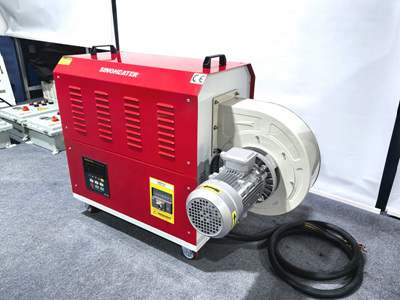Regular inspection of the internal circuits of the hot air blower is a key measure to ensure the safe operation of the equipment, prevent electrical faults and fire hazards. The following systematically sorts out the key points of inspection and operation norms from four dimensions: line integrity, connection reliability, insulation performance, and environmental adaptability.
First, check the integrity of the lines
Appearance inspection of wires
Damage identification: Check whether the outer sheath of the wire is cracked, worn or aged (such as hardened or brittle), with particular attention to the bending points and fixed points.
Case warning: A hot air blower in a certain factory suffered a short circuit due to the wear of the outer sheath of the wire, causing a fire with losses exceeding 500,000 yuan.
Handling measures: Replace the wire immediately upon discovery of damage. It is strictly prohibited to temporarily repair it with insulating tape.
Rationality of line layout
Wiring specification: Ensure that the wires are kept away from high-temperature components (such as heating tubes, motors), sharp edges and moving parts.
Fixation requirements: Use wire clamps or cable ties to secure the wires to prevent shaking or friction.
Standard reference: Refer to GB 5226.1-2019 “Mechanical and Electrical Safety”, the wire spacing should be ≥5mm.
Second, connection reliability check
Terminal block fastening
Torque requirements: Use a torque wrench to check if the terminal blocks (such as power terminals and thermostat wiring) are loose. The tightening torque must comply with the manufacturer’s regulations (for example, for M4 bolts, 1.2-1.5N·m is required).
Oxidation treatment: For terminals that have turned black due to oxidation, sand them with sandpaper and then apply conductive paste.
The compatibility of plugs and sockets
Specification matching: Ensure that the plug and socket models are consistent (for example, a 16A three-pronged plug corresponds to a 16A socket), and do not mix them.
Contact test: Use a multimeter to measure the contact resistance between the plug and the socket, which should be ≤0.1Ω.
Third, insulation performance testing
Insulation resistance test
Test tool: Use a 500V megohmmeter to measure the insulation resistance between the wire and the ground wire, as well as between the wires.
Qualified standard: Insulation resistance should be ≥1MΩ (≥0.5MΩ in a humid environment).
Case Analysis: The insulation resistance of a certain hot air blower was only 0.2MΩ. During operation, leakage of electricity caused an electric shock to the operator.
Withstand voltage test
Test voltage: Apply 1500V AC voltage to a 220V line for 1 minute. If there is no breakdown or flashover, it is qualified.
Note: The withstand voltage test should be conducted by professionals to avoid accidental exposure to high voltage.
Fourth, environmental adaptability inspection
Moisture-proof and waterproof
Sealing inspection: Confirm that the sealing gaskets of the junction box and control box are not aged and the waterproof grade is no less than IP54.
Humidity control: In damp environments (such as bathrooms and basements), it is recommended to install dehumidification devices or use moisture-proof wires.
Dust-proof and anti-corrosion
Dust accumulation cleaning: Regularly clean the dust inside the control box to prevent poor heat dissipation or short circuits caused by dust accumulation.
Anti-corrosion treatment: Apply anti-rust oil to the metal terminal blocks to prevent oxidation and corrosion.
Fifth, special inspection of key components
Thermostat and sensor circuits
Signal test: Use a multimeter to check whether the output signal of the temperature controller (such as 4-20mA) is stable. The error should be ≤±2%.
Shielding layer inspection: Ensure that the shielding layer of the sensor signal line is well grounded to avoid electromagnetic interference.
Motor circuit
Phase sequence detection: Use a phase sequence meter to detect the phase sequence of the three-phase motor wiring to ensure the correct rotation direction.
Current monitoring: Use a clamp meter to measure the operating current of the motor, which should be ≤ 110% of the rated current.
Sixth, inspection cycle and records
Suggested inspection cycle
Daily inspection: Before each use, check the appearance and fixation of the wires.
Monthly inspection: Tighten the terminal blocks and test the insulation resistance.
Annual inspection: Conduct withstand voltage tests and comprehensively investigate the aging problems of the lines.
Summary
Regular inspection of the internal circuits of the hot air blower should follow the closed-loop process of “appearance – connection – insulation – environment”, with particular attention paid to wire damage, loose terminals, insulation aging and environmental adaptability. Through standardized inspection and record-keeping, the risk of electrical faults can be reduced by over 80%, and the service life of equipment can be extended by 2 to 3 times. If serious problems are found (such as insulation resistance < 0.5MΩ), the machine should be stopped immediately and professional personnel should be contacted for handling.



